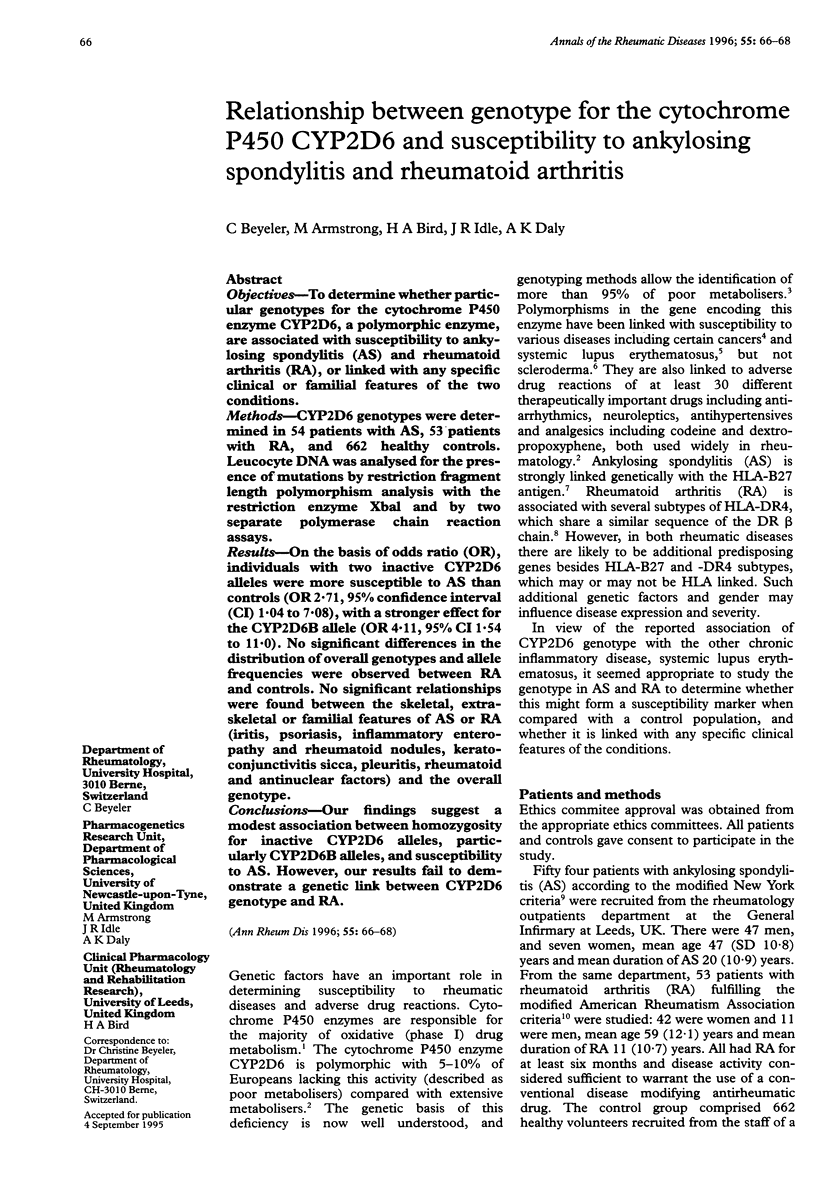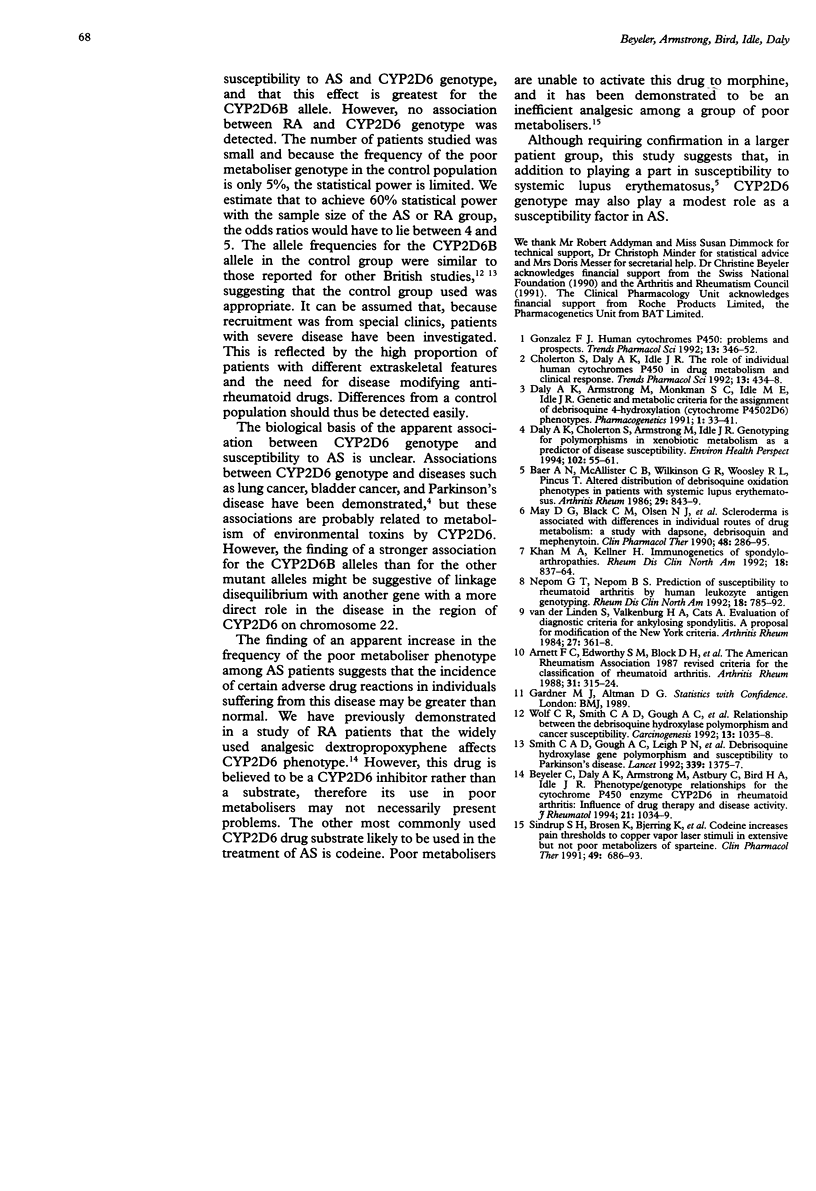Abstract
OBJECTIVES--To determine whether particular genotypes for the cytochrome P450 enzyme CYP2D6, a polymorphic enzyme, are associated with susceptibility to ankylosing spondylitis (AS) and rheumatoid arthritis (RA), or linked with any specific clinical or familial features of the two conditions. METHODS--CYP2D6 genotypes were determined in 54 patients with AS, 53 patients with RA, and 662 healthy controls. Leucocyte DNA was analysed for the presence of mutations by restriction fragment length polymorphism analysis with the restriction enzyme Xbal and by two separate polymerase chain reaction assays. RESULTS--On the basis of odds ratio (OR), individuals with two inactive CYP2D6 alleles were more susceptible to AS than controls (OR 2.71, 95% confidence interval (CI) 1.04 to 7.08), with a stronger effect for the CYP2D6B allele (OR 4.11, 95% CI 1.54 to 11.0). No significant differences in the distribution of overall genotypes and allele frequencies were observed between RA and controls. No significant relationships were found between the skeletal, extraskeletal or familial features of AS or RA (iritis, psoriasis, inflammatory enteropathy and rheumatoid nodules, kerato-conjunctivitis sicca, pleuritis, rheumatoid and antinuclear factors) and the overall genotype. CONCLUSIONS--Our findings suggest a modest association between homozygosity for inactive CYP2D6 alleles, particularly CYP2D6B alleles, and susceptibility to AS. However, our results fail to demonstrate a genetic link between CYP2D6 genotype and RA.
Full text
PDF


Selected References
These references are in PubMed. This may not be the complete list of references from this article.
- Arnett F. C., Edworthy S. M., Bloch D. A., McShane D. J., Fries J. F., Cooper N. S., Healey L. A., Kaplan S. R., Liang M. H., Luthra H. S. The American Rheumatism Association 1987 revised criteria for the classification of rheumatoid arthritis. Arthritis Rheum. 1988 Mar;31(3):315–324. doi: 10.1002/art.1780310302. [DOI] [PubMed] [Google Scholar]
- Baer A. N., McAllister C. B., Wilkinson G. R., Woosley R. L., Pincus T. Altered distribution of debrisoquine oxidation phenotypes in patients with systemic lupus erythematosus. Arthritis Rheum. 1986 Jul;29(7):843–850. doi: 10.1002/art.1780290705. [DOI] [PubMed] [Google Scholar]
- Beyeler C., Daly A. K., Armstrong M., Astbury C., Bird H. A., Idle J. R. Phenotype/genotype relationships for the cytochrome P450 enzyme CYP2D6 in rheumatoid arthritis: influence of drug therapy and disease activity. J Rheumatol. 1994 Jun;21(6):1034–1039. [PubMed] [Google Scholar]
- Cholerton S., Daly A. K., Idle J. R. The role of individual human cytochromes P450 in drug metabolism and clinical response. Trends Pharmacol Sci. 1992 Dec;13(12):434–439. doi: 10.1016/0165-6147(92)90140-2. [DOI] [PubMed] [Google Scholar]
- Daly A. K., Armstrong M., Monkman S. C., Idle M. E., Idle J. R. Genetic and metabolic criteria for the assignment of debrisoquine 4-hydroxylation (cytochrome P4502D6) phenotypes. Pharmacogenetics. 1991 Oct;1(1):33–41. doi: 10.1097/00008571-199110000-00006. [DOI] [PubMed] [Google Scholar]
- Daly A. K., Cholerton S., Armstrong M., Idle J. R. Genotyping for polymorphisms in xenobiotic metabolism as a predictor of disease susceptibility. Environ Health Perspect. 1994 Nov;102 (Suppl 9):55–61. doi: 10.1289/ehp.94102s955. [DOI] [PMC free article] [PubMed] [Google Scholar]
- Gonzalez F. J. Human cytochromes P450: problems and prospects. Trends Pharmacol Sci. 1992 Sep;13(9):346–352. doi: 10.1016/0165-6147(92)90107-h. [DOI] [PubMed] [Google Scholar]
- Khan M. A., Kellner H. Immunogenetics of spondyloarthropathies. Rheum Dis Clin North Am. 1992 Nov;18(4):837–864. [PubMed] [Google Scholar]
- May D. G., Black C. M., Olsen N. J., Csuka M. E., Tanner S. B., Bellino L., Porter J. A., Wilkinson G. R., Branch R. A. Scleroderma is associated with differences in individual routes of drug metabolism: a study with dapsone, debrisoquin, and mephenytoin. Clin Pharmacol Ther. 1990 Sep;48(3):286–295. doi: 10.1038/clpt.1990.151. [DOI] [PubMed] [Google Scholar]
- Nepom G. T., Nepom B. S. Prediction of susceptibility to rheumatoid arthritis by human leukocyte antigen genotyping. Rheum Dis Clin North Am. 1992 Nov;18(4):785–792. [PubMed] [Google Scholar]
- Smith C. A., Gough A. C., Leigh P. N., Summers B. A., Harding A. E., Maraganore D. M., Sturman S. G., Schapira A. H., Williams A. C., Maranganore D. M. Debrisoquine hydroxylase gene polymorphism and susceptibility to Parkinson's disease. Lancet. 1992 Jun 6;339(8806):1375–1377. doi: 10.1016/0140-6736(92)91196-f. [DOI] [PubMed] [Google Scholar]
- Wolf C. R., Smith C. A., Gough A. C., Moss J. E., Vallis K. A., Howard G., Carey F. J., Mills K., McNee W., Carmichael J. Relationship between the debrisoquine hydroxylase polymorphism and cancer susceptibility. Carcinogenesis. 1992 Jun;13(6):1035–1038. doi: 10.1093/carcin/13.6.1035. [DOI] [PubMed] [Google Scholar]
- van der Linden S., Valkenburg H. A., Cats A. Evaluation of diagnostic criteria for ankylosing spondylitis. A proposal for modification of the New York criteria. Arthritis Rheum. 1984 Apr;27(4):361–368. doi: 10.1002/art.1780270401. [DOI] [PubMed] [Google Scholar]


